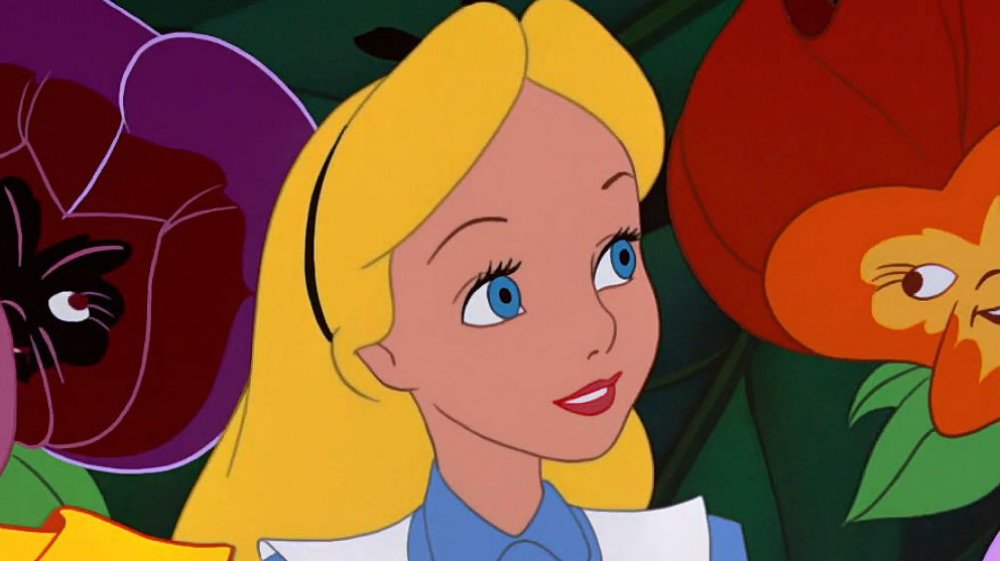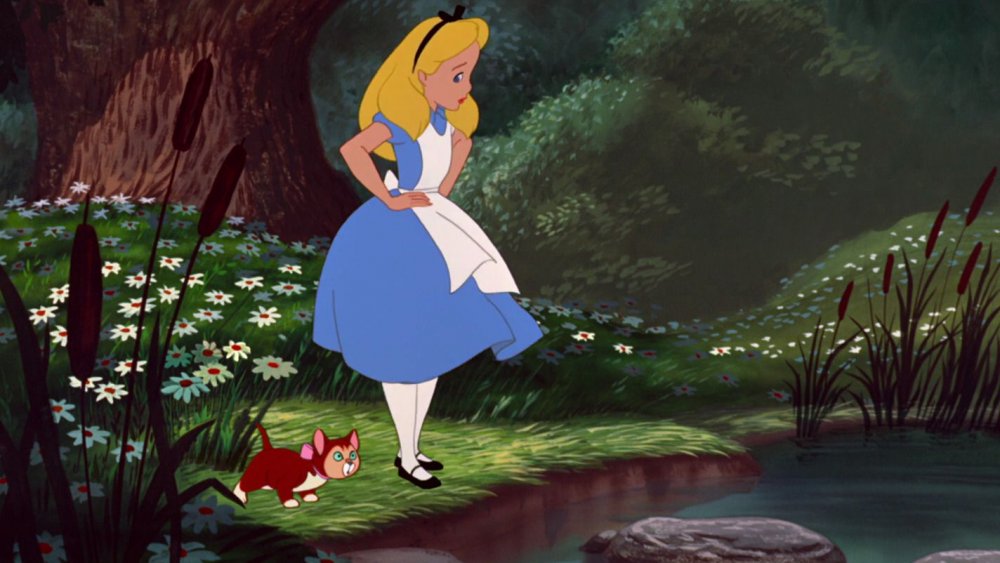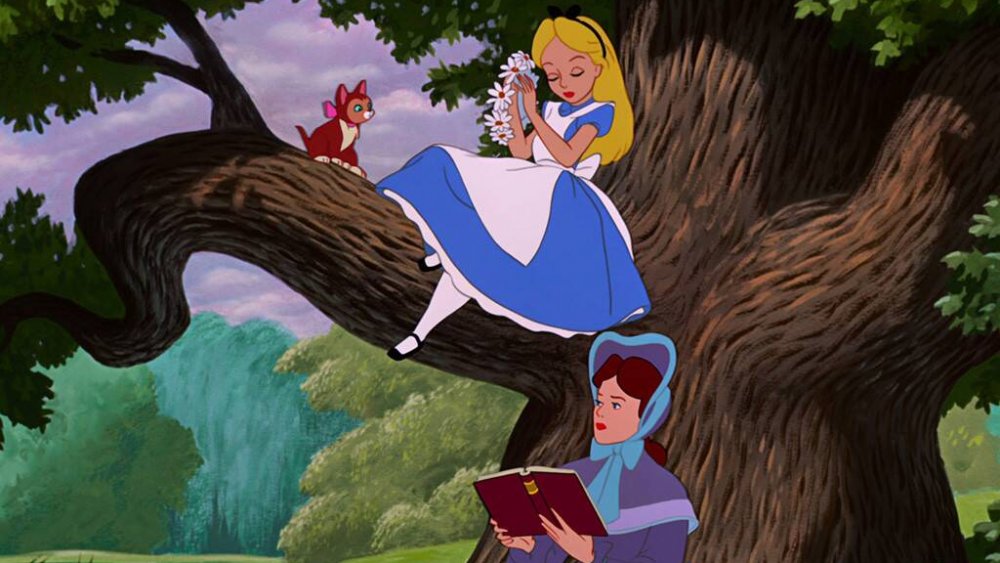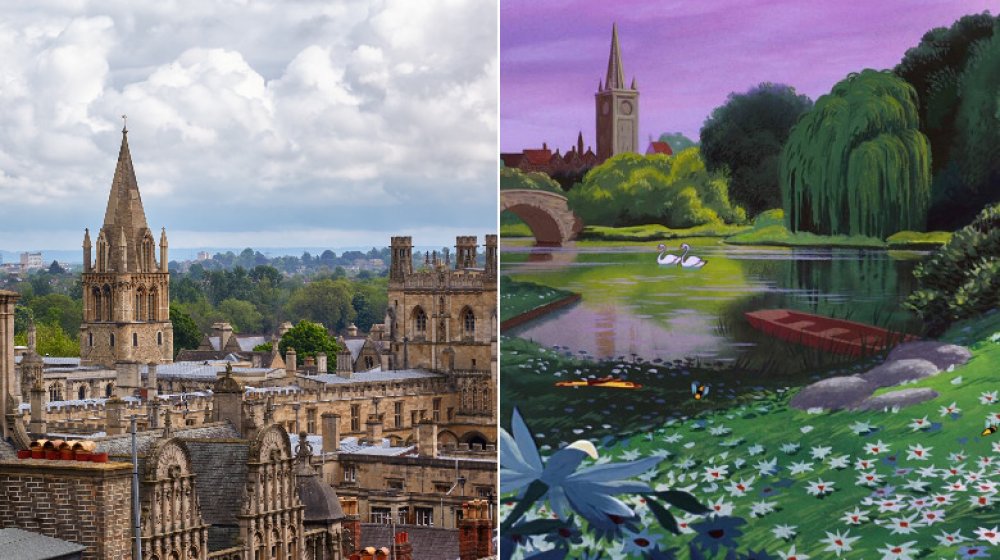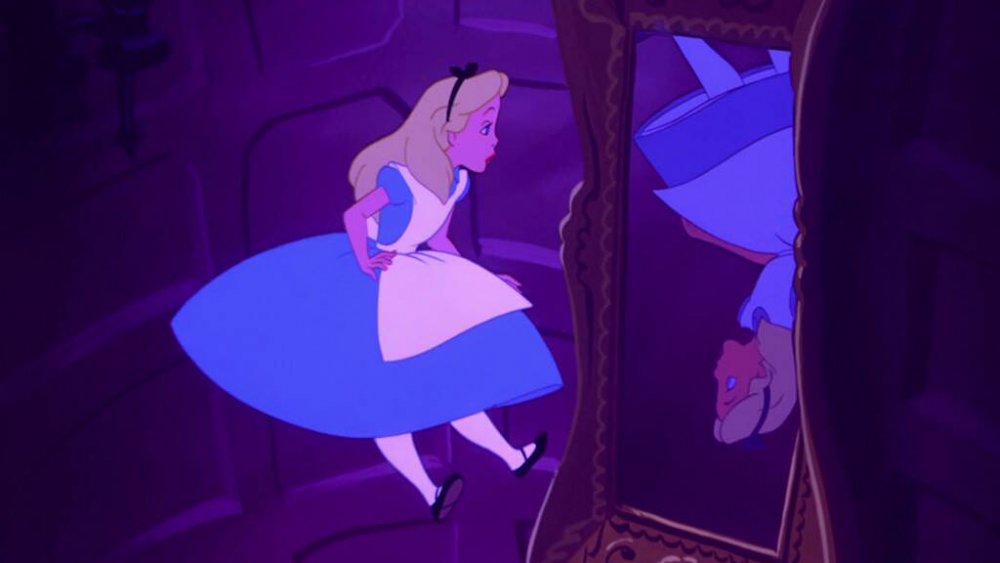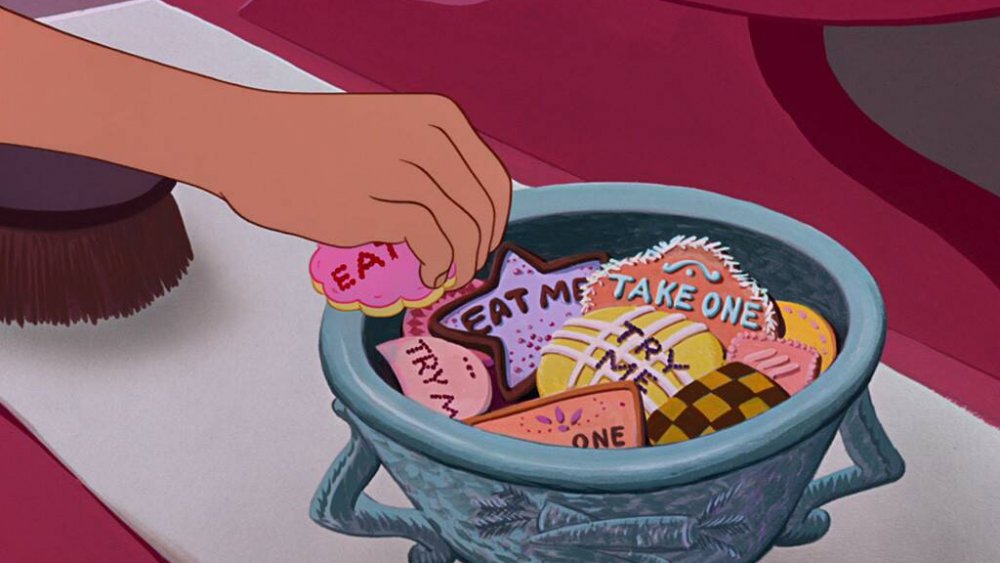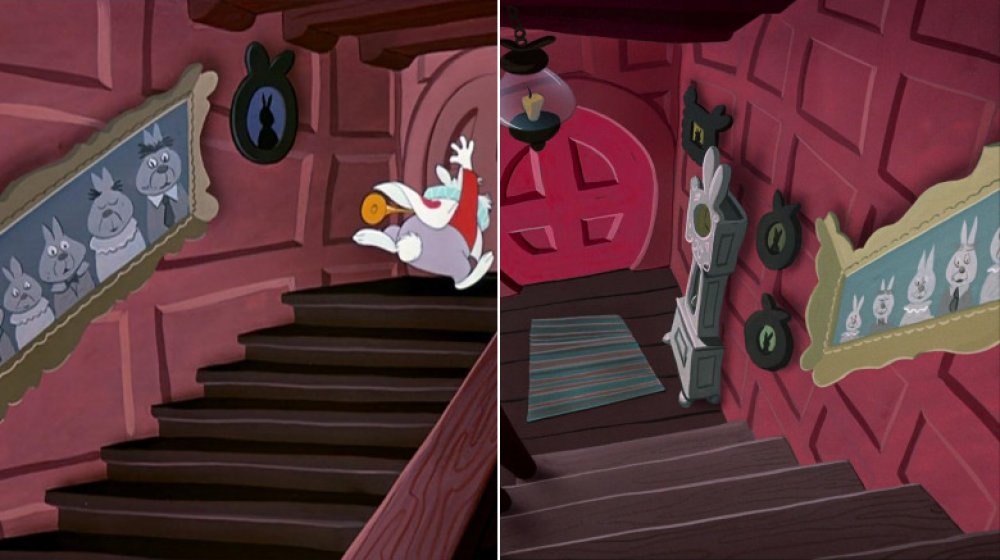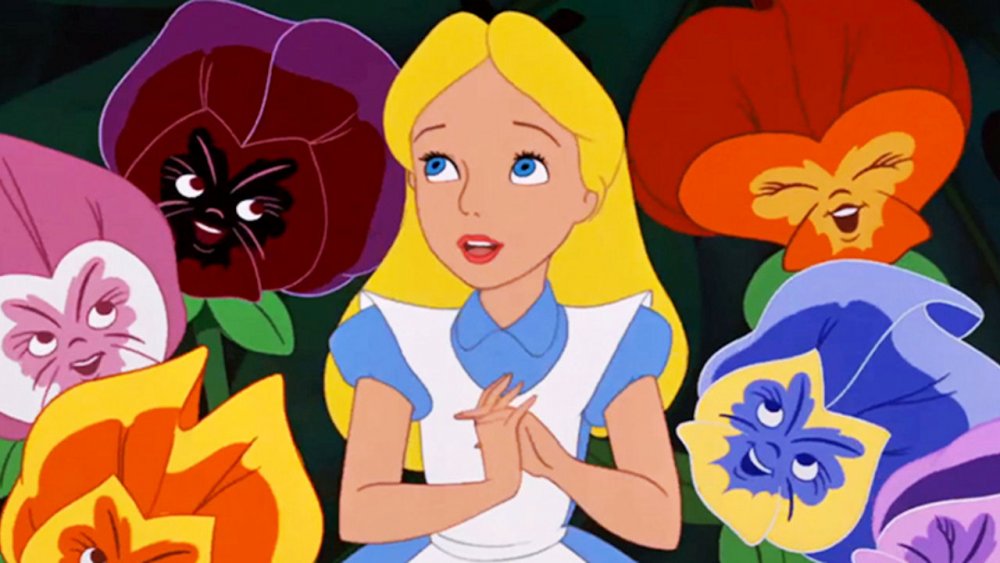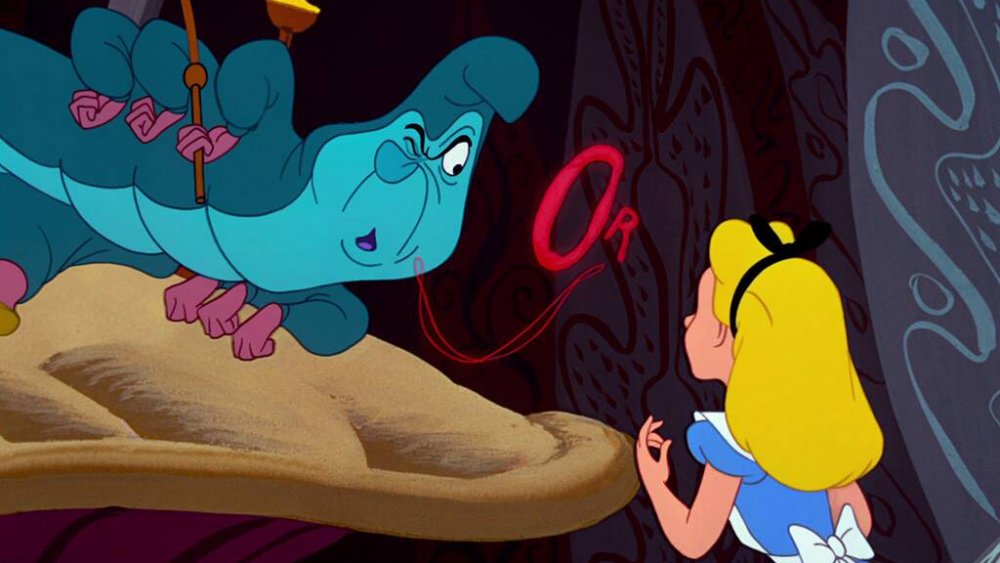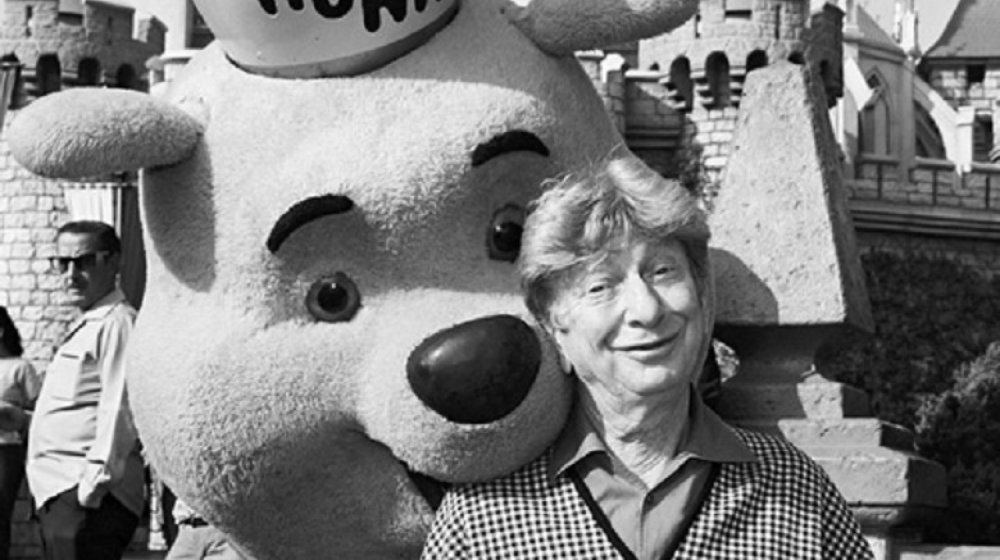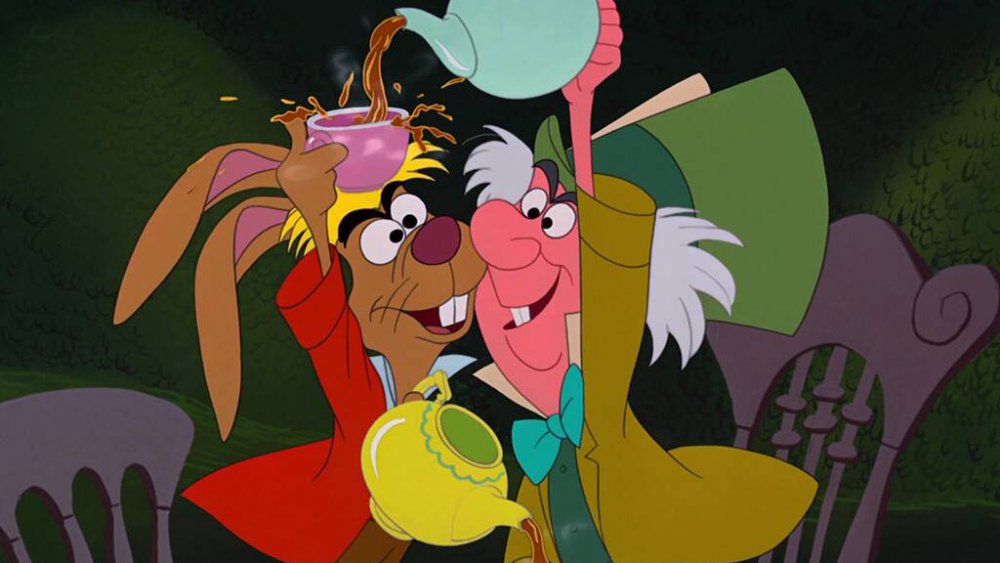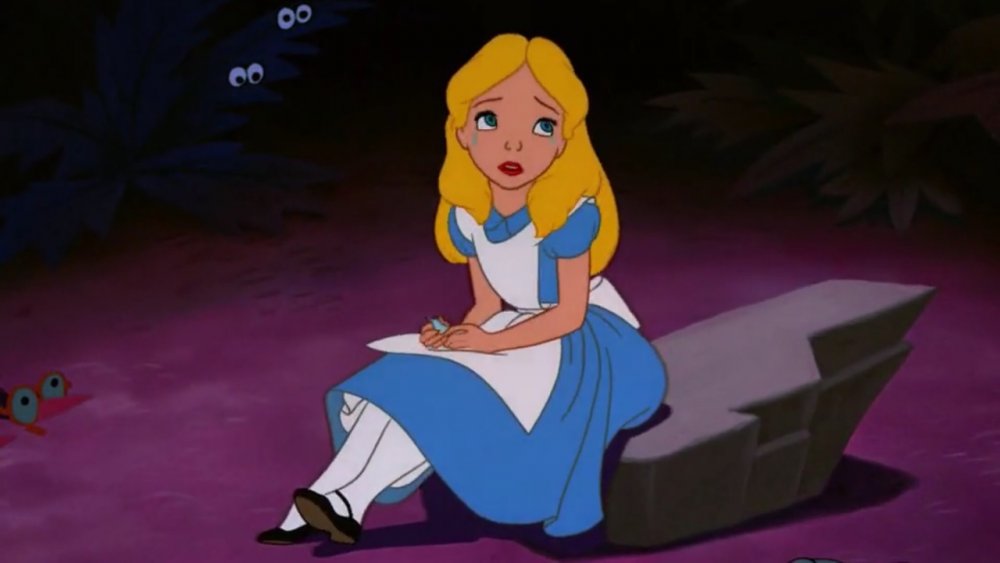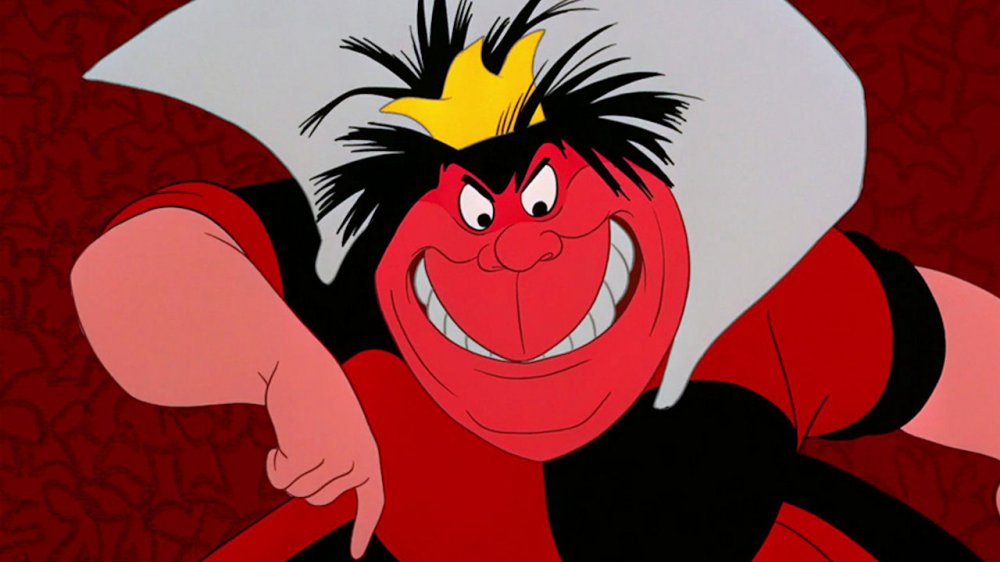Things Only Adults Notice In Alice In Wonderland
The best stories transcend time, space, and cultural divides, and Lewis Carroll's Alice's Adventures in Wonderland is no exception. Since being published in 1865, this timeless tale of whimsical adventure has been translated into more than 170 languages and dialects, and adapted into dozens of films, plays, and animations. The most notable of these, of course, is Disney's classic 1951 animated feature — which ironically received a lukewarm response from audiences at the time of its release, who felt the movie wasn't true enough to Carroll's original text. Nevertheless, as the years passed and viewers' tastes changed, Disney's Alice evolved into a beloved standalone interpretation, and became a quintessential childhood experience.
Filled with a whirlwind of colorful characters and beautiful, Oscar-nominated music, Alice in Wonderland provides a captivating escape for kids of all ages. Who doesn't love following Alice down the rabbit hole of her vivid imagination and singing along with memorable tunes like "The Walrus and the Carpenter" and "The Unbirthday Song?" When revisiting the film as an adult, however, one can't help but notice details younger minds might miss. From real-life Medieval history to psychedelic drugs to Eastern philosophy, here's everything you missed as a kid while watching Alice in Wonderland ... but can't un-see once you've grown-up.
Where are her parents?
When watching Alice in Wonderland as an adult in the 21st century, it becomes immediately apparent how unsupervised Alice is. Although her sister appears to be old enough to look out for the both of them, the lack of any adult presence throughout the course of the film prompts older minds to wonder where the girls' guardians are.
When the film hit theaters in the early 1950s, "free range children" were the norm, rather than the exception. Kids used to be told to play outside with other neighborhood children and come home when the streetlights came on. Entire hours would go by where the only parent any kid encountered was Mother Nature. My, how times have changed since the first half of the 1900s — or even the '80s! Modernization often improves many aspects of society, but modern times also come with novel problems and challenges. Thanks to everything from infectious disease to advancements in computing, kids nowadays are found inside on electronics far more frequently than they're seen playing outside. Safety is always the number one priority in child rearing, but nothing benefits developing minds like climbing trees and scraped knees. Alice has the edge on modern youngsters there — not that they'll notice while watching her escapades.
Fantasy rooted in real history
Before he put pen to paper, Lewis Carroll's stories originated as oral tales he regaled colleagues and their children with, while boating between Oxford and Woodstock — two locations rooted deep in English history. Eager to entertain older minds as well as younger ones, Carroll took inspiration from his surroundings and his experiences in higher education, layering them into his stories as they developed.
Childish fancy is plainly apparent in his stories, but they are also laden with subtle hints at more mature subjects, including riddles and numbers games, critical thinking, philosophy, and local history. Disney's Alice in Wonderland unfolds with Alice's older sister reading her excerpts from some of that history — which Alice complains "doesn't have enough pictures." As it turns out, this scene features quotes from a real-life historical text: Havilland Chepnell's Short Course of History.
This same book was studied by Alice Liddell, one of Carroll's dearest child-friends, and the real-life inspiration for Alice in Wonderland. Throughout his life, Carroll was friends with the children of his colleagues, which was actually pretty normal for a Victorian bachelor — but the nature of these friendships and Carroll's sexual identity has long been a hotbed of debate among scholars. Interestingly, the chosen excerpt is from a chapter examining the rise and fall of the House of Normandy, an era of history rife with noblewomen and princesses named Alice.
The film takes place in Oxford
Sharp eyes will note a distinctive tower shape in the background of the opening and closing scenes of Alice in Wonderland, which has left many kids wondering if Alice lives in a castle. In fact, this is none other than Christ Church Cathedral, site of the prestigious Oxford University in which Carroll lived, studied, and worked for his entire adult life.
Before he was an author, Lewis Carroll was known best by his birth name, Charles Lutwidge Dodgson. He was a brilliant mathematician and inventor, devoted scholar, and deacon of the Anglican Church, all of which would influence his fiction later in life. James Joyce, Salvador Dalí, numerous video game and comic book creators, and, of course, Walt Disney have all been influenced by Carroll's work. As a further homage to Alice in Wonderland's real-world origins and influences, a rowboat can be spotted in a pond in the first scene. This was thoughtfully placed as an homage to the camaraderie-filled boat-rides which helped inspire Carroll's fictional works.
Exploring the unconscious mind
As a kid, watching Alice in Wonderland is a simple, whimsical diversion into technicolor fantasy. As an adult, however, one can't help but derive deeper meaning from what otherwise seems like nonsense — particularly in regards to psychology and philosophy.
Alice's adventures are launched the moment she trails her fingers across the surface of a garden pond. In its reflection appears the White Rabbit, running late as ever. This imagery, and her ensuing fall down the rabbit hole, can be interpreted as symbolizing the unconscious mind, which can only be accessed via dreams, trances, or other similar states. Hidden within the unconscious mind, according to some psychologists and philosophers, are all the unknown aspects of oneself, including repressed urges, fears, traumas, and beliefs. Dreaming is one way for the unconscious mind to communicate with the conscious mind, particularly when one is undergoing a psychological imbalance that can be harmful to one's well-being — sort of like how a car's check engine light alerts its owner to issues they might otherwise miss. Carl Jung called these revelatory visions "Big Dreams," and dedicated his life to the study and interpretation of symbolic dream imagery. Likewise, the dream imagery in Alice in Wonderland has not gone unnoticed by academics, and continues to be studied and discussed.
Exactly what kind of edibles and mushrooms are those?
While some mature viewers see a prolific use of dream symbolism in Alice in Wonderland, others hold a very different and far more controversial perspective: That she is actually under the influence of mind-altering substances. Throughout the course of the film, Alice consumes a variety of beverages, pastries, and mushrooms, all of which alter her perspective by causing her to grow or shrink in size. The use of mushrooms in particular spurs this theory on, which was initially popularized by the counterculture movement of the 1960's.
In particular, the rock band Jefferson Airplane stoked the fires of this theory with the release of their 1967 hit, "White Rabbit." "One pill makes you larger, and one pill makes you smaller," goes the first verse of the song, "and the ones that mother gives you don't do anything at all." The song goes on to make further psychedelic allusions to the hookah-smoking caterpillar, and Red Queen being "off her head" from drug use.
This track became an iconic anthem of '60s counterculture, and ushered in a slew of similar interpretations from other artists and authors, including Go Ask Alice, a fictional account of a teen girl's spiral into addiction. Ironically, Lewis Carroll has no documented history of pervasive drug use, and likely would be rather appalled by this interpretation.
At it like rabbits
Many animation studios, including Disney, have become notorious for layering adult humor into their films, prompting older viewers to hit pause. Alice in Wonderland is no exception, although overall it has far fewer pause-worthy moments than other Disney favorites. Hey, it was a more innocent time — plus, Robin Williams wasn't around yet to sneak Jack Nicholson jokes into kids' movies.
About midway through the movie, Alice finds herself stuck inside the White Rabbit's house after nibbling on a pastry which makes her grow to monstrous proportions. In an effort to escape the house before he is crushed by her rapidly growing limbs, the Rabbit runs downstairs and out his front door. Sharp eyes following his path will note a family portrait lining the stairs — but this is no ordinary domestic depiction. Whereas your average family unit is composed of several members, there are so many children and other relations pictured in the Rabbit's family that one single frame runs the entire length of the stairs. "Multiplying like rabbits" isn't an idiom kids know, but adults surely notice the tongue-in-cheek joke.
Body-shaming flowers
"Golden Afternoon" is one of the most beautiful songs from Alice in Wonderland. This delightful singalong is shared with Alice by a group of anthropomorphic flowers. The gorgeous scenery they provide makes this a high point of the movie — that is, until the flowers take a shocking turn in their attitudes.
Curious about their unexpected guest's origins, they ask Alice what kind of garden she comes from. But when she explains she doesn't come from a garden, the cultivated blossoms assume she has more uncouth origins as a wildflower, and their attitudes darken. They then go on to criticize Alice's appearance with rude statements clearly meant to cause her emotional distress over her physical appearance: "Just look at those stems! Rather scrawny, I think. Did you notice her petals? What a peculiar color!"
When a sweet-natured baby rosebud remarks that she thinks Alice is pretty, her mother tells her to be quiet while covering her mouth. The turbulence gets kicked up even more when Alice declares she's not a flower, which drives the others to assume she is "nothing more" than a "common weed." This assumption stirs them into a frenzy, eager to shoo Alice away before she "goes to seed" and spreads "weeds in their bed." How rude! Alice is right when she declares they could "learn a few things about manners." Body-shaming is wrong, as adults know well — even when it comes from plants.
The deep philosophy of the hookah-smoking Caterpillar
For as long as humans have existed, we've marveled over the puzzling nature of who we are and how we came to be. This is a deeply complex inquiry to undertake, and throughout the millennia, various cultures have developed a myriad of theories and worldviews in an attempt to answer it.
On the surface, Alice's encounter with the hookah-smoking Caterpillar is merely a silly series of puns — likewise, his exclamations of "Who are you?!" can be interpreted as simple questioning from one stranger to another. However, mature viewers might note hints of Eastern philosophy inserted into his discourse. Schools of thought and religions from the far East, like Taoism and Buddhism, often interrogate concepts of an individual "self," separate from the divine. Instead, many believe the sensation of self is a hallucination, and hold to the philosophy that all beings are manifestations of one energy source. Consider Zen koans, which are thought exercises designed to break the student out of stagnant ways of thinking and stimulate enlightenment. Whether he is philosophizing or merely making inquiries of a passing stranger, the Caterpillar sure is aggressive with his questioning. It's probably safe to assume he's smoking something other than mellow pipe-weed from his golden hookah.
The voice actor of the Cheshire Cat also did Winnie the Pooh
Since animation has permeated popular culture over the last century, viewers have come to identify characters by the sound of their voice just as much as their outward appearance. Thanks to many talented actors, these characters are brought to life in ways that transcend the written word or still images. Some voice actors are true masters, capable of portraying dozens of characters for various features in their lifetimes, each with a unique voice and cadence. One of those legendary talents was the great Sterling Holloway, who voice-acted in more than one hundred radio programs, TV shows, and animated films during a prolific career spanning nearly five decades.
Sterling took on numerous projects for Disney during that time, voicing iconic characters like Sleepy in Snow White and the Seven Dwarves, Winnie the Pooh, and even the Cheshire Cat in Alice in Wonderland. It's easy to miss as a kid, but adult ears will find Sterling's unique, tinny rasp easy to identify.
The March Hare needs to take it down a notch
One Alice in Wonderland scene that happens to be layered with grown-up meaning only lasts for a quick moment. Once you've noticed it, however, it can't be ignored.
While having a dizzyingly wacky tea party with the Mad Hatter and March Hare, Alice enjoys a light conversation with her hosts — if you can call their wildly disconnected banter such a thing. Over the course of their gibberish musings, Alice attempts to explain her backstory, mentioning her cat, Dinah, in the process. At the sound of a female's name, the March Hare pants heavily in a fairly suggestive manner. He then asks who Dinah is, to which Alice replies, "Why, Dinah is my cat." This unleashes a fresh wave of chaos involving a paranoid dormouse and jar of jam, and the previous moment is quickly forgotten — by everyone except quick-eyed adults, that is. Well, he is a rabbit, and you know how they like to multiply.
Growing up is hard
In the beginning of the movie, Alice longs to live in a world of fantasy and "nonsense," instead of the real world with all its rigidities. After getting exactly what she hoped for in Wonderland's zany atmosphere, Alice reaches a breaking point at a literal end in her path. Alone and scared, she longs for the grounded reality of her home and family in one of the most pitiful scenes in Disney animation.
This whole scene pulls on the heartstrings of viewers of all ages, but definitely carries more gravity for adult viewers. Only a grown-up can understand on a deeply visceral level how confusing and terrifying coming-of-age can be. Crying alone on a rock, Alice mourns losing her way: "That's just the trouble with me. I give myself very good advice, but I very seldom follow it." This is a lament many adults can identify with all too well. As Alice sheds her tears, the fantastical creatures surrounding her fade away into the dark, as though her disheartening revelations are degrading her imagination. Maturity literally corrodes fanciful innocence. Thankfully, the Cheshire Cat appears, and illuminates the path forward once more for Alice.
The final scenes with the Red Queen are actually super morbid
After her depressing coming-of-age moment and subsequent rescue by the Cheshire Cat, Alice finds herself in the Red Queen's kingdom. To her dismay, Alice quickly learns this royal ruler has serious anger issues. Switching between a calm, ladylike demeanor, and maniacal, serial killer-level wrath, the Red Queen carries her weight around with all the grace of an elephant in a glassware shop.
The fear of their queen is so deeply instilled, Alice finds anthropomorphic playing cards painting white roses red, because they accidentally planted the wrong color. When the Queen catches them in the act, she demands their death by execution: "Off with their heads!" This phrase is a notable favorite of the Red Queen, who not only expresses a repeated desire to commit murder, but also commits acts of animal cruelty. In a twisted version of croquet, the Queen uses live animals in place of traditional equipment: Flamingos replace mallets, hedgehogs are used in place of balls, and playing cards replace hoops. Even as a kid, it can be hard to not feel bad for the poor creatures as they're batted about. Thankfully, Alice escapes the Red Queen's rage, returning home safe and sound by awaking from what appears to be a dream. Apparently, Alice fell asleep while her older sister was reading Medieval history to her ... or so it seems.
